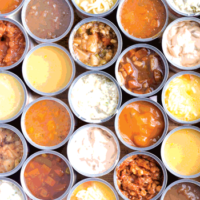Thermal treatments are critical in controlling foodborne pathogens in ready-to-eat (RTE) meat and poultry products.[1] Thermal processing accomplished in meat and poultry processing establishments is still one of the most useful tools to effectively eliminate or reduce to acceptable levels any pathogenic bacteria that may be potentially present in meat and poultry products. Because thermal processing has historically been so effective and, in many cases, regarded as the ultimate “safe harbor” for food safety, it can easily also be one of those technologies where a critical understanding and appropriate application of the product-specific thermal processes can be unintentionally overlooked.
Thermal processing is applied to literally hundreds of types of RTE products, from hams to jerky and from lunchmeats to hot dogs. Yet, many of these products are thermally processed using a variety of procedures, schedules and equipment. Further, almost all of these products have unique compositions, ingredients and other characteristics that can create a different response to the thermal process technology employed. Thus, it is important to understand how different thermal processing systems and schedules affect pathogen lethality, and how the products themselves can also affect overall lethality.
Lethality is defined as the reduction of a target pathogen during heating to a level, ideally zero, that renders a product safe for consumption at any point during its shelf life. There are, however, three additional nuances of lethality that must be included for practical thought and consideration: 1) The pathogen of concern must first be present for lethality to be effective, and since raw product microbial sampling is not conducted in a way to efficiently or effectively validate presence or absence, we inherently consider the pathogen is present. 2) The lethality process must be effective in reducing pathogen numbers to a safe level. This can be a bit of a sticking point as most lethality requirements are at least 5-log colony-forming unit (CFU)/g or higher. These “high” log levels are chosen to achieve a very conservative log reduction, as these levels would almost never be present on raw materials. However, if considering potential growth during the come-up time (time prior to lethality temperature conditions) of the thermal process and the potential for any survivors of the thermal process and their needed control afterwards, these “high” lethality requirements may be well justified. 3) Any variation within the manufacturing process such as differences in product thickness or variation incurred during the thermal process, such as from oven hot spots, also supports the idea of a more conservative approach.
Current and Common Validation for Thermal Processing
Unless a proprietary in-plant validation has been conducted, U.S. Department of Agriculture Food Safety Inspection Service (USDA FSIS) Appendix A and the Process Lethality Spreadsheet [available from the American Meat Institute (AMI) Foundation at www.amif.org/process-lethality/] are the two most commonly utilized science-based thermal processing tools available and are employed by the meat industry to ensure and validate the thermal destruction of pathogenic microorganisms during cooking. Like all tools, neither is perfect, with both having their strengths and weaknesses.
The USDA FSIS Appendix A “Compliance Guidelines for Meeting Lethality Performance Standards for Certain Meat and Poultry Products” document has been used extensively by the meat industry and universally accepted by regulatory bodies as a safe harbor to provide lethality of harmful, pathogenic bacteria in RTE meat and poultry products for many years.[2] Appendix A was developed from research conducted by Goodfellow and Brown in 1978[3] on the fate of Salmonella inoculated in beef (roast beef), and since its introduction as a compliance guideline has gained widespread acceptance and application by both industry and regulatory entities. Due to the study design, death curves were able to be generated yielding important and useful time-temperature combinations designed to reduce Salmonella by 7 logs. Revered as a critical document for food safety, Appendix A has been applied to a wide array of products beyond roast beef, including ham, hot dogs, luncheon meats and jerky, to name a few. Although Appendix A is widely used as validation support for thermal processes, its time-temperature tables and humidity requirements were originally developed and validated only for Salmonella in roast beef.
In a USDA-published guidance document regarding the use of Appendix A for nonbeef products, the authors stated:
Appendix A is intended primarily as guidance for processors of cooked poultry products and cooked beef, corned beef, and roast beef. The time and temperature tables in Appendix A also can be used as supporting documentation for the heat treatment of other RTE meat and poultry products if such products’ critical factors are equivalent to the products specifically covered in Appendix A.
Industry’s widespread use of a document originally developed for roast beef has raised question about its appropriateness and validity for non-roast beef products. The USDA FSIS release of “Draft Guidance — HACCP Systems Validation” on April 2012[4] has strongly suggested the safety of meat and poultry products must be scientifically supported through validation. This draft guidance has brought into question the scientific appropriateness of Appendix A as support documentation for thermal processing of products that were not included in the original study.
To provide additional thermal processing tools for the meat industry, numerous research studies have been published over the past several decades to provide lethality criteria for pathogenic bacteria, but with the exception of Appendix A, these data have not been translated into tools the industry can easily use. Reasons for this lack of adoption include inability of laboratory studies to be translated into an industry practice/setting, study results not validated in commercial systems or in products outside the scope of the tested product (i.e., studies performed in media systems) and shortcomings identified in research designs (i.e., depth or complexity of experimental design). Even relevant studies are often overlooked or have only limited adoption due to the need for laborious searches and highly skilled interpretations of scientific articles. In other cases, little benefit can be realized if the scope of information is too narrow, resulting in self-restricting data, as is the case with the time-temperature tables for cooking RTE poultry.[5] For example, tables developed for cooking chicken and turkey with different fat contents to achieve a 7-log reduction of Salmonella have not met industrywide needs because of the narrow fat ranges (1–12%) included in the study and therefore limit their practical use.
The “AMI Process Lethality Determination Spreadsheet,” on the other hand, is much more dynamic and valuable for understanding total log reductions expected and includes additional aspects of integrated lethality if used to its maximum design potential. However, its practical usefulness has been constrained by the availability of the inputs (i.e., D- and z-values; see below for explanation of these inputs) that must be included in the spreadsheet to perform lethality calculations. Typically found in scientific journal articles, these inputs are usually generated for limited products with specific attributes (e.g., meat species, fat level, water activity, etc.). As such, studies that generate these inputs are not common and because countless combinations of intrinsic and physical factors would be needed to represent all meat products thermally processed, the spreadsheet has some limitations. However, if a worst case-scenario approach is taken (e.g., whole muscle inputs are used for a ground product), extrapolation can successfully take place. In other words, if we know what effects the intrinsic and physical attributes have on thermal processing, considerations can be made and the spreadsheet can be expanded for products that are encompassed within these factors.
Validation Considerations
If focusing only on product-related responses to pathogen reduction via cooking, many compositional (e.g., fat, moisture, protein, etc.), physical (e.g., shape, size, etc.) or intrinsic (e.g., pH, water activity, etc.) factors and/or differences should be understood and considered. Heat resistance of microbes is affected by several factors, including bacterial and food properties. The bacterial properties include pathogen of interest, cell concentration, phase of growth, bacterial strain and exposure to stressors such as acid or salt.[6, 7] The intrinsic properties of food and ingredients also influence heat resistance as some food components are protective and impart a higher heat resistance for the pathogens. For example, higher fat content,[8] low water activity (aw < 0.94) at temperatures below 127–131 °F[9] and varying levels of solutes (e.g., salt, sodium phosphates)[10] can provide protective effects for Salmonella. The bacterial strains themselves also present inactivation differences. Studies completed with multiple strains of Salmonella, including serotype Senftenberg, report variable differences in log-reduction rates between Salmonella and Listeria monocytogenes, particularly when heated in different substrates, such as pork, turkey or beef products.[11, 12] In some cases, Salmonella has been shown to have greater heat resistance than L. monocytogenes. Current research in our laboratory, however, has shown otherwise. Thermal resistance of Salmonella is further increased in whole muscle product compared with ground product.13
Thermal processing systems, including the equipment used and the thermal processes followed with that equipment, are another consideration that should be carefully evaluated and/or reviewed for the ability to successfully achieve desired lethality. Meat and poultry products are heat-treated using a variety of thermal processing equipment and even an array of different thermal processes using the same equipment. However, the efficacy of a desired pathogenic log reduction can be impacted by any of the previously described causes for several reasons such as the following:
• Improper equipment is used for the thermal processing task
• Thermal processing equipment is not being well maintained and/or validated for performance (e.g., oven balance, prevention of cold spots, proper airflow, etc.)
• Thermal processes are not adequately developed to address variations/changes in product, environment or process conditions
• The cooking equipment is not designed to meet thermal processing targets established by the plant
• Failure to understand the design of a thermal process and the impact that may have on lethality in a given scenario (or with a given piece of thermal processing equipment)
• Failure to follow a conservative cooking approach to ensure lack of thermal deviation
• Failure to understand what impact the food product’s compositional, physical or intrinsic factors might have on overall lethality
One method to understand the lethality effect caused by thermal processing while also taking into consideration the various peripheral elements of lethality is to utilize D- and z-values. Considered useful tools for thermal processing, D- and z-values provide the ability to simply and accurately understand lethality—regardless of many of the peripheral factors mentioned. A D-value is defined as the specific temperature at which a 90 percent (1-log) pathogen reduction has occurred, whereas a z-value is defined as the change in temperature necessary to increase the D-value by an additional log (factor of 10). Many of us use D- and z- values, and likely don’t realize it. USDA FSIS Appendix A was developed from the generation of D- and z-values from the experiments conducted. For example, following the Appendix A cooking temperature of 140 °F, 12 minutes is needed to achieve a 7-log reduction of Salmonella (12 minutes/7 log equals a D-value of 1.71 minutes). Thus, by knowing the D-values for different pathogenic bacteria and in different products, predicted lethality can be quickly determined.
Validation Research
Currently, our laboratory is completing a study funded by the AMI Foundation titled “Developing validated time-temperature thermal processing guidelines for ready-to-eat deli meat and poultry products” (www.amif.org/research/10-304/). The aims are to begin the collection of baseline/foundational thermal processing data and subsequent generation of thermal processing food safety knowledge and tools to contribute to thermal processing food safety. The goals of the study were to 1) measure D- and z-values for Salmonella, L. monocytogenes and Shiga toxin-producing Escherichia coli (STEC) in roast beef, turkey deli breast and boneless ham; 2) validate the measured D-values in commercial products and processes; and 3) generate data to a) update Appendix A time-temperature tables for roast beef and b) develop new Appendix A-style, time-temperature tables for turkey deli breast and boneless ham product types/categories.
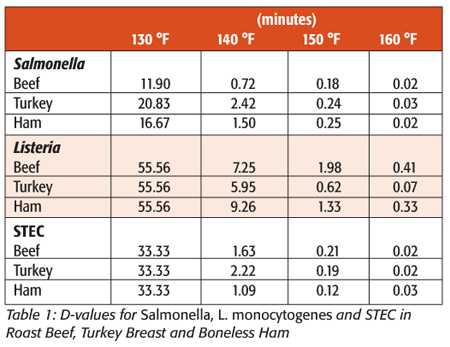 This research was completed in two phases. In Phase I, ground turkey breast (containing 1.5% salt, 1.5% dextrose and 20% water), ground roast beef (containing 2.0% salt, 0.35% sodium phosphates, 0.75% sugar and 20% water) and ground ham (containing 2.5% salt, 1.65% sugar, 0.35% sodium phosphates, 547 ppm sodium erythorbate, 200 ppm sodium nitrite and 20% water) were inoculated with 8-log CFU/g L. monocytogenes or Salmonella (5-strain mix) or STEC (7-strain mix). One-gram portions (0.5–1.0 mm in moisture-impermeable vacuum pouches) were heated at one of four temperatures (130, 140, 150 or 160 °F) in a water bath. Triplicate samples were removed and immediately chilled to less than 40 °F when the meat reached the target temperature and at seven additional times. Surviving L. monocytogenes, Salmonella or STEC were enumerated using Modified Oxford, XLD or Sorbitol MacConkey agar base, respectively, with a thin-layer overlay of nonselective media to enhance recovery of injured cells. Each study was replicated twice. Linear regressions of the data were used to calculate D- and z-values for each treatment combination (three product types × three pathogens × four temperatures; Tables 1 and 2). From these data, treatment combinations were selected for validation using commercial production processes. Table 3 shows the treatment combinations used for validation in Phase II.
This research was completed in two phases. In Phase I, ground turkey breast (containing 1.5% salt, 1.5% dextrose and 20% water), ground roast beef (containing 2.0% salt, 0.35% sodium phosphates, 0.75% sugar and 20% water) and ground ham (containing 2.5% salt, 1.65% sugar, 0.35% sodium phosphates, 547 ppm sodium erythorbate, 200 ppm sodium nitrite and 20% water) were inoculated with 8-log CFU/g L. monocytogenes or Salmonella (5-strain mix) or STEC (7-strain mix). One-gram portions (0.5–1.0 mm in moisture-impermeable vacuum pouches) were heated at one of four temperatures (130, 140, 150 or 160 °F) in a water bath. Triplicate samples were removed and immediately chilled to less than 40 °F when the meat reached the target temperature and at seven additional times. Surviving L. monocytogenes, Salmonella or STEC were enumerated using Modified Oxford, XLD or Sorbitol MacConkey agar base, respectively, with a thin-layer overlay of nonselective media to enhance recovery of injured cells. Each study was replicated twice. Linear regressions of the data were used to calculate D- and z-values for each treatment combination (three product types × three pathogens × four temperatures; Tables 1 and 2). From these data, treatment combinations were selected for validation using commercial production processes. Table 3 shows the treatment combinations used for validation in Phase II.

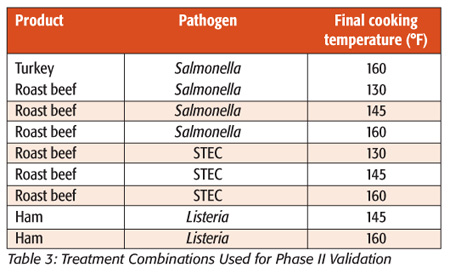 In Phase II, turkey breast, roast beef and ham were manufactured according to the same formulations used in the first phase, inoculated with 8-log CFU/g of the designated pathogen cocktail and stuffed into 4-inch-diameter casings (Table 3). Treatments were then cooked to one of three target temperatures (130, 145 or 160 °F) using either a step-up steam (turkey breast and roast beef) or wet bulb/dry bulb (ham) thermal process. Triplicate samples were removed from the core, midpoint and surface of each chub (Figure 1) for enumeration of surviving pathogens at three predetermined time points during each thermal process (130 °F - sampled at 130, 130 +1 h, and 130 °F +2 h; 145 °F - sampled at 130, 145, and 145 °F +5 min; 160 °F - sampled at 130, 145, and 160 °F). Additional samples were processed after chilling to less than 40 °F to account for integrated lethality during cooling. Thermal process profiles were generated for each treatment combination by measuring product core, midpoint and surface temperatures as well as environmental (wet-bulb/dry-bulb) conditions (Figure 2). Surviving L. monocytogenes, Salmonella or STEC were enumerated using Modified Oxford, XLD or Sorbitol MacConkey agar, respectively, with a thin-layer overlay of nonselective media to enhance recovery of injured cells.
In Phase II, turkey breast, roast beef and ham were manufactured according to the same formulations used in the first phase, inoculated with 8-log CFU/g of the designated pathogen cocktail and stuffed into 4-inch-diameter casings (Table 3). Treatments were then cooked to one of three target temperatures (130, 145 or 160 °F) using either a step-up steam (turkey breast and roast beef) or wet bulb/dry bulb (ham) thermal process. Triplicate samples were removed from the core, midpoint and surface of each chub (Figure 1) for enumeration of surviving pathogens at three predetermined time points during each thermal process (130 °F - sampled at 130, 130 +1 h, and 130 °F +2 h; 145 °F - sampled at 130, 145, and 145 °F +5 min; 160 °F - sampled at 130, 145, and 160 °F). Additional samples were processed after chilling to less than 40 °F to account for integrated lethality during cooling. Thermal process profiles were generated for each treatment combination by measuring product core, midpoint and surface temperatures as well as environmental (wet-bulb/dry-bulb) conditions (Figure 2). Surviving L. monocytogenes, Salmonella or STEC were enumerated using Modified Oxford, XLD or Sorbitol MacConkey agar, respectively, with a thin-layer overlay of nonselective media to enhance recovery of injured cells.
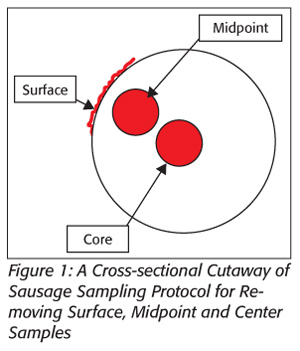
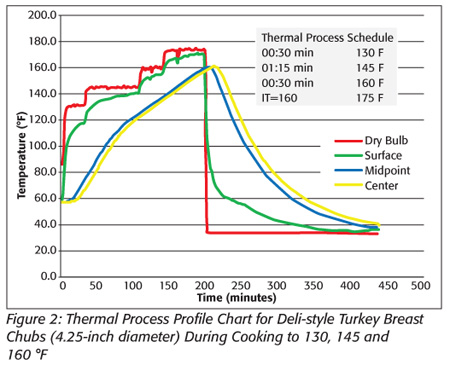 In all product types investigated, inactivation rates for STEC were similar to Salmonella at 140, 150 or 160 °F, and were comparable to or less than times reported in USDA FSIS Appendix A. In contrast, L. monocytogenes showed greater thermotolerance than Salmonella and STEC under all conditions. For example, a greater than 5-log reduction of Salmonella and STEC in turkey was achieved instantaneously at 160 °F, whereas L. monocytogenes was inactivated within 10 seconds. At 145 °F, a greater than a 5-log reduction of L. monocytogenes required 30 and 50 minutes in turkey and ham, respectively, as compared with less than 12 minutes for Salmonella and STEC. At the lowest temperature tested (130 °F), a greater than 5-log reduction of Salmonella, STEC and L. monocytogenes in all product types was achieved in less than 2, 2.8 and 4.6 hours, respectively. Preliminary results from Phase I support Appendix A as an acceptable tool for Salmonella and STEC lethality, and as expected, L. monocytogenes was more thermotolerant than either Salmonella or STEC. Since Phase I data were generated using model systems and 1-g meat samples, only immediate lethality was measured, whereas integrated lethality was not accounted for to determine expected total lethality in a commercial process.
In all product types investigated, inactivation rates for STEC were similar to Salmonella at 140, 150 or 160 °F, and were comparable to or less than times reported in USDA FSIS Appendix A. In contrast, L. monocytogenes showed greater thermotolerance than Salmonella and STEC under all conditions. For example, a greater than 5-log reduction of Salmonella and STEC in turkey was achieved instantaneously at 160 °F, whereas L. monocytogenes was inactivated within 10 seconds. At 145 °F, a greater than a 5-log reduction of L. monocytogenes required 30 and 50 minutes in turkey and ham, respectively, as compared with less than 12 minutes for Salmonella and STEC. At the lowest temperature tested (130 °F), a greater than 5-log reduction of Salmonella, STEC and L. monocytogenes in all product types was achieved in less than 2, 2.8 and 4.6 hours, respectively. Preliminary results from Phase I support Appendix A as an acceptable tool for Salmonella and STEC lethality, and as expected, L. monocytogenes was more thermotolerant than either Salmonella or STEC. Since Phase I data were generated using model systems and 1-g meat samples, only immediate lethality was measured, whereas integrated lethality was not accounted for to determine expected total lethality in a commercial process.
Validation during Phase II confirmed that cooking to 160 °F was sufficient to kill more than 6 logs of the three pathogens in all the products tested. STEC and Salmonella were similarly inactivated in roast beef when cooked to 145 °F, but the additional lethality contributed during cooling was necessary to inactivate more than 6 logs of L. monocytogenes in ham cooked to a final temperature of 145 °F.
At the time of this writing, final experiments are currently being conducted for Salmonella and STEC 130 °F roast beef treatments.
Summary
Given thermal processing’s importance for producing safe, high-quality meat and poultry products, the need for a critical understanding and appropriate application of thermal processing cannot be emphasized enough. An examination of thermal processing protocols and important effectiveness checks might reveal an area for food safety improvement. Scientific research studies should continually addresses this important part of the food safety chain by providing new thermal processing guidance to appropriately support methods to address pathogenic bacteria in RTE meat products. Further, research studies that generate D- and z-values as well as contribute to a better understanding, such as additional lethality impacts from integrated lethality, will be important for establishing new data for use in pathogen modeling programs and overall enhancement of thermal processing food safety.
 Jeff J. Sindelar, Ph.D., is an associate professor and extension meat specialist at the University of Wisconsin, Madison. His research focus is on improving the quality, sensory qualities and safety of processed meats. He is a member of the Institute of Food Technologists, the International Association for Food Protection and the American Meat Science Association.
Jeff J. Sindelar, Ph.D., is an associate professor and extension meat specialist at the University of Wisconsin, Madison. His research focus is on improving the quality, sensory qualities and safety of processed meats. He is a member of the Institute of Food Technologists, the International Association for Food Protection and the American Meat Science Association.
 Amanda King is a graduate student completing her Ph.D. in meat science at the University of Wisconsin, Madison. Her research has focused on improving the safety of alternatively cured meats and thermal processing food safety.
Amanda King is a graduate student completing her Ph.D. in meat science at the University of Wisconsin, Madison. Her research has focused on improving the safety of alternatively cured meats and thermal processing food safety.
References
1. www.fsis.usda.gov/wps/wcm/connect/210d3d19-96bc-4b1e-8829-325e25e63e0b/Salm_RTE_Risk_Assess_Sep2005.pdf?MOD=AJPERES.
2. www.fsis.usda.gov/wps/portal/frame-redirect?url=http://www.fsis.usda.gov/OPPDE/rdad/FRPubs/95-033F/95-033F_Appendix_A.htm.
3. Goodfellow, S.J. and W.L. Brown. 1978. Fate of Salmonella inoculated into beef for cooking. J Food Prot 41:598–605.
4. www.fsis.usda.gov/wps/wcm/connect/a70bb780-e1ff-4a35-9a9a-3fb40c8fe584/HACCP_Systems_Validation.pdf?MOD=AJPERES.
5. www.fsis.usda.gov/wps/wcm/connect/dc59bbed-54c3-4e48-97f0-585e0ad9f846/Appendix_A_guidance_95-033F.pdf?MOD=AJPERES.
6. O’Bryan, C.A., P.G. Crandall, E.M. Martin, C.L. Griffis and M.G. Johnson. 2006. Heat resistance of Salmonella spp., Listeria monocytogenes, Escherichia coli O157:H7, and Listeria innocua M1, a potential surrogate for Listeria monocytogenes, in meat and poultry: A review. J Food Sci 71:R23–R30.
7. Orta-Ramirez, A., B.P. Marks, C.R. Warsow, A.M. Booren and E.T. Ryser. 2005. Enhanced thermal resistance of Salmonella in whole muscle compared to ground beef. J Food Sci 70:M359–M362.
8. Juneja, V. and B. Eblen. 2000. Heat inactivation of Salmonella Typhimurium DT104 in beef as affected by fat content. Lett Appl Microbiol 30:461–7.
9. Aljarallah, K. and M. Adams. 2007. Mechanisms of heat inactivation in Salmonella serotype Typhimurium as affected by low water activity at different temperatures. J Appl Microbiol 102:153–60.
10. Juneja, V.K., H.M. Marks and T. Mohr. 2003. Predictive thermal inactivation model for effects of temperature, sodium lactate, NaCl and sodium pyrophosphate on Salmonella serotypes in ground beef. Appl Environ Microbiol 69:5138–5156.
11. Juneja, V.K. 2003. A comparative heat inactivation study of indigenous microflora in beef with that of Listeria monocytogenes, Salmonella serotypes and Escherichia coli O157:H7. Lett Appl Microbiol 37:292–298.
12. Murphy, R.Y., B.L. Beard, E.M. Martin, L.K. Duncan and J.A. Marcy. 2004. Comparative study of thermal inactivation of Escherichia coli O157:H7, Salmonella, and Listeria monocytogenes in ground pork. J Food Sci 69:FMS97–FMS101.
13. Orta-Ramirez, A., B.P. Marks, C.R. Warsow, A.M. Booren and E.T. Ryser. 2005. Enhanced thermal resistance of Salmonella in whole muscle compared to ground beef. J Food Sci 70:M359–M362.
Thermal Processing with Food Safety in Mind


